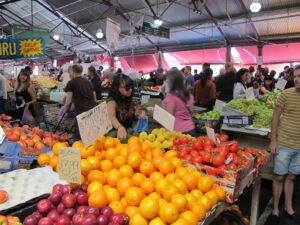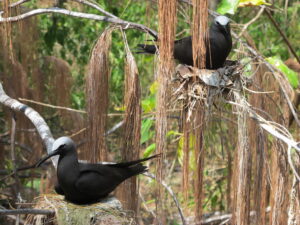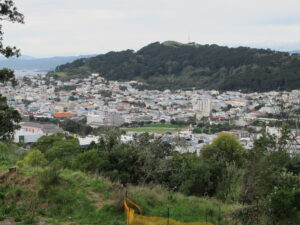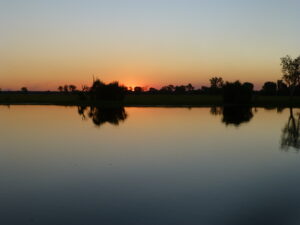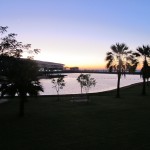
We walked through the streets of Darwin in the early Monday morning. We expected a quiet city after our red-eye flight dropped us into town before dawn. With nothing open, we took the opportunity to trek over to the gleaming waterfront development at the top end of the city where those rising early – or still there very late at night – can watch sunrise over the Timor Sea, next stop East Timor or Papua New Guinea, both closer than Queensland.
The shiny new waterfront development was impressive, but seemed even emptier in the dawn. There are some attractions here: we later heard tales of the wave lagoon, with a dozen different kinds of wave patterns, and a saltwater swimming lagoon somewhere, as well as a thriving night life at the now closed bars and restaurants. By 7am, however, the one breakfast place open at the waterfront looked like a fast food spot, and didn’t even offer views onto the water.
Yet, as we returned to the city center, we didn’t expect the strange quiet of the town to continue. Some people and cars were moving about, but otherwise there was an eerie stillness about the place. Where are all the people, we wondered. Is it like this all the time?
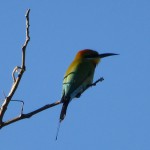
By mid-morning we were walking the picturesque Esplanade of Bicentennial Park, enjoying the shady trees, gazing at the plentiful birds and staring west out to sea. But even here, it felt like early Sunday not Monday, as we passed just a few scattered runners and some visitors we recognized from our own overnight flight.
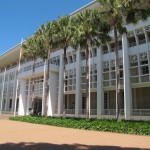
At lunchtime, we tried several restaurants that looked interesting. All closed today. In the afternoon, we visited the park-like grounds of the Northern Territory’s governmental buildings and did a surprisingly entertaining self-tour of the huge Parliament House, a 20 year old modernist riff on a Greek temple. We expected to see a throng of tourists there, but we seemed to be alone with the two guards as we passed through an airport security screening.
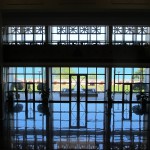
We finally decided to ask them about the missing people. Waving a tabloid newspaper headline at us, they explained the mystery. We had unwittingly arrived on another of those unusual Australian holidays, Derby Day, the day of a big horse race in town. We knew about the Melbourne Cup, another holiday in Victoria centered on a horse race, so in a way this was no surprise. Apparently, by now, a huge portion of the town – whether tourist or resident – was at the racetrack for the event.
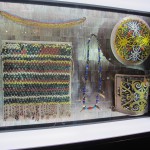
Strangely, we found out the next day that Darwin actually had once been turned into a ghost town. Our source was an exhibit at the excellent Museum and Art Gallery of the Northern Territory, a few kilometers outside of town, across a busy highway from the unusually informal botanic garden. On Christmas Eve of 1974, cyclone Tracy destroyed virtually every building and home for the 48,000 residents of the town. All were soon evacuated, but the city was rebuilt. A decade later it had returned to the same size.
By the evening of Derby Day, Darwin became party city, rocking with drinking and conversation, as the people returned from the racetrack and occupied the innumerable bars along Mitchell Street. The women outshone the men in dressing for the event. Fanciful hats topped most heads, with odd shoots springing from them. High heels, and yet higher heels, clip-clopped down the street. All the party duds – fancy dresses, short dresses, clingy dresses – were on display. At last together with some people, we decided to squeeze into the crowd at the Fox Ale House; soon we were chatting with Aussie tourists up from the east coast for a break and a quartet of locals.
Darwin, which was actually named for Charles Darwin by an officer visiting on the HMS Beagle, has long been a center for tourists even aside from Derby Day. It is the launch point for trips to several spectacular parks, Kakadu to the east, Litchfield to the south and Katherine Gorge farther south, as well as within reach of Purnululu (the Bungle Bungle range) and the pristine coastline of the Timor Sea. Tour operators offer adventure and sight-seeing opportunities every other storefront.
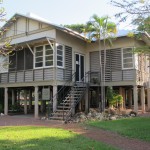
We learned from the four locals we met, however, how Darwin was changing for its residents, evolving from a small town into a big city. Even to our eyes, money appeared to be flowing here: in projects like the waterfront development we had seen and the clumping of apartment buildings in Cullen Bay Harbor at the sunset end of the Darwin city center (leaving some wonderful colonial era buildings untouched). And then there were the cranes erecting serviced apartment buildings everywhere you looked. One of the men we met had actually been responsible for constructing a set of nearby apartments in record time, pressed by the developers to get the job done to meet demand.
The people to fill those apartments, along with the flow of funds, were coming because of the rapid expansion of several industries in the area over the last 15 to 20 years. Mining, gas extraction, along with agriculture made possible by irrigation projects, all created jobs and brought workers from elsewhere. Nearby Asian export markets made up the demand. This economic growth formed a different, more benign cyclone, transforming the town into one of the fastest growing in all Australia.
The contractor told us how just a dozen years ago he could walk the streets of Darwin and pretty much recognize every one of the residents. You could barely get down the street for greeting everybody you knew. We looked out for each other, he bragged, and kept an eye on the kids. His wife said they would get calls from parents telling them their daughter was still over at the rail station, apparently the nefarious place to hang out back a few years. “Ya better come pick her up,” they’d advise.

That was when the Greater Darwin population was about 80,000. With over 130,000 now and the pipeline for more open, Darwin’s small town character seemed to be fading forever in the eyes of the long-time residents. “You don’t hardly recognize someone on the street anymore,” we were told.
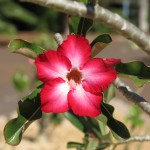
With only two days in town, we couldn’t really tell. During our conversation with the contractor couple, however, we saw a lot of people greet them, and many nearby seemed to know each other well.
Then we learned that the city still had the heart of a small town. During the prize race at Derby Day, a female jockey was thrown by her thoroughbred and died from her injuries. Her family received all the prize money.



